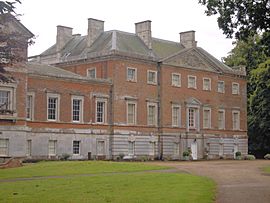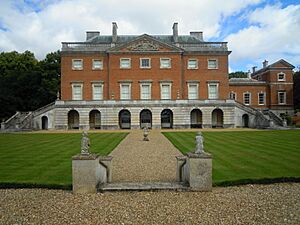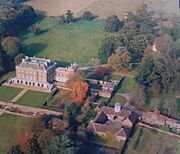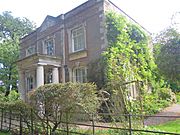Wolterton Hall facts for kids
Quick facts for kids Wolterton Hall |
|
|---|---|

North elevation
|
|
| General information | |
| Type | Historic house |
| Architectural style | Georgian |
| Town or city | Near Aylsham, Norfolk, NR11 7LY |
| Country | England |
| Coordinates | 52°50′26″N 1°12′37″E / 52.840635°N 1.210311°E |
| Completed | 1742 |
| Inaugurated | 1725 |
| Renovated | 1828 |
| Client | Horatio Walpole |
| Technical details | |
| Structural system | Brick, Portland stone cladding (ground floor) |
| Design and construction | |
| Architect | Thomas Ripley George Stanley Repton (east wing, 1828) |
| Other designers | Charles Bridgeman (parkland and lake) William Gilpin (gardens) |
Wolterton Hall is a big country house in Norfolk, England. It's located near the villages of Wickmere and Wolterton. A man named Horatio Walpole, 1st Baron Walpole of Wolterton had this house built. It was finished in 1742. The architect who designed it was Thomas Ripley. He was helped by Lord Walpole and his brother, Sir Robert Walpole.
Contents
What's in a Name?
The name Wolterton comes from an old Anglo-Saxon word. It means "Wulfthryth's settlement" or "farm." Wulfthryth was a woman's name.
History of Wolterton Hall
The land where Wolterton Hall stands today once had an older manor house. This old house belonged to Sir Henry Spelman. There was also a village called Wolterton nearby. This village was later abandoned. Only the old church tower remains a short distance north of the hall.
Maps from 1733 show that the deserted village had several houses. They were grouped around a village green. Wolterton village is mentioned in the Domesday Book. This was a big survey of England made in 1086.
- The Domesday Book listed the village as Ultertuna and Wivetuna.
- The main landowner was a Norman nobleman, William de Warenne.
- The survey showed four small farms on the land.
- Before 1066, the Abbot of St. Benedict of Holme owned some land.
- This land was worth 16 shillings (about 80p) then.
- By the time of the survey, it was worth 20 shillings (£1).
Horatio Walpole's Vision
Horatio Walpole, 1st Baron Walpole of Wolterton bought the old manor house and land in 1722. He wanted to fix it up. Horatio was the younger brother of Sir Robert Walpole. Robert is known as the first Prime Minister of Great Britain.
Horatio was also a politician and a diplomat. He had worked in The Hague and was the Ambassador to France. This was from 1724 to 1730.
- In 1724, a fire destroyed the old house.
- This changed Horatio's plans for the estate.
- He hired the architect Thomas Ripley to help rebuild.
Building the New Hall
Thomas Ripley was put in charge of designing and building the new hall. He had also worked for Horatio's brother Robert at Houghton. Ripley designed a neoclassical country house. It had a rectangular shape and three floors.
- The ground floor was made of Portland stone.
- The upper floors used pale red bricks made nearby.
- The windows were sash windows. They had stone frames around them.
- The main entrance was on the north side. It had Tuscan columns.
- This entrance was changed into a window in the 1800s.
- The roof was made with Welsh slate.
Changes Over Time
Horatio Walpole, 3rd Earl of Orford was the great-grandson of the first Horatio Walpole. He inherited the hall and made many changes. In 1828, he hired architect George Repton. George was the son of a famous landscape designer.
- George Repton added a new Palladian wing on the east side.
- This wing had two floors and connected to a larger three-story section.
- He also added a stone arcade to the south side.
- This arcade had seven arches and a balcony above.
- Staircases led from the balcony down to the gardens.
Inside Wolterton Hall
The inside of the hall was designed with beautiful details. The marble hall was once the main entrance. It has four mahogany doors. These doors were a gift from Queen Caroline, who was the wife of King George II.
- The marble hall has a fireplace made of white marble and colored agate.
- The room also has a fancy plaster ceiling.
- The house has a central stairwell with a dome.
- The stone staircase seems to float without support.
- It has a wrought iron railing shaped like a lyre.
Horace Walpole's study was decorated by an Italian painter named Jacopo Amigoni. He used a fancy Baroque and Rococo style. Many rooms have beautiful fireplaces. The walls are decorated with paintings of the family.
Gardens and Parklands
The hall is surrounded by beautiful parkland and gardens. These were designed by Charles Bridgeman. He also created a lake south of the hall in 1725. This lake was made from an older water feature. In the 1830s, an island was added to the lake. It was planted with cedar trees.
The old medieval church of St Margaret's is now a ruin. Only its round tower is still standing. It is made of flint, brick, and stone. It is a very important historical building.
The Norfolk Turkey
Lady Dorothy Nevill wrote about Wolterton Hall in her book. She said that Horatio Walpole, the first Baron, received a good payment each year. This money helped him buy wood for the hall. He bought walnut for doors, windows, and shutters.
Horatio also brought American turkeys to the estate. These turkeys lived in the woods around Wolterton. It is thought that these turkeys were the start of the popular Norfolk turkey breeds we know today.
Later Years of the Hall
The Walpole family lived at Wolterton Hall until 1858. That's when Horatio Walpole, 3rd Earl of Orford passed away. The next Earl, also named Horatio, moved to nearby Mannington Hall. Wolterton Hall was empty for many years.
- In 1905, restoration work began.
- Robert Walpole, 5th Earl of Orford started the work.
- He moved back into Wolterton from Mannington.
- He lived there until he passed away in 1931.
The 5th Earl had no children. So, he left the house and estate to a cousin. This was Robert Henry Walpole. He became the 7th Baron Walpole of Wolterton. He was a descendant of Thomas Walpole, the second son of the first Baron.
In 1950, the 7th Baron opened the house to the public. People could come and visit.
The Fire of 1952
In 1952, a fire broke out in a bedroom on the second floor. The fire destroyed the entire floor. It also caused a lot of water damage to the room below. Firefighters worked hard to put out the fire.
- Firefighters, estate workers, and neighbors helped.
- Even a group of boys from Old Buckenham Hall preparatory school helped.
- They all worked together to save many items from the house.
- The firefighters were very brave. They saved priceless art and furniture.
Lord Walpole started to restore the hall soon after the fire. After three years, the hall was open to the public again.
Recent History
In 1989, the hall and estate were inherited by the 8th Baron Walpole. He lived at Mannington Hall. He said he wanted to protect the hall and its estate. However, in 1999, he sold hundreds of acres of land. In 2015, he put the hall and 500 acres of land up for sale.
In April 2016, two interior designers, Peter Sheppard and Keith Day, bought the house and parkland. They started a big restoration project. In 2022, their restoration work won an award from the Georgian Group. It also won an award from the Historic Houses Association. In 2023, Wolterton Hall was sold to a local businessman, Richard Ellis, and his family.
Gallery








